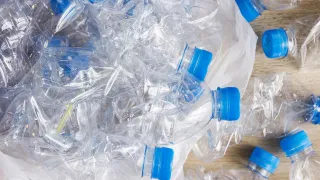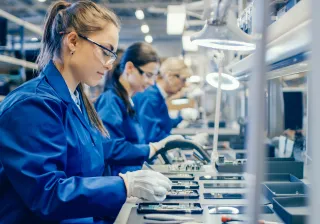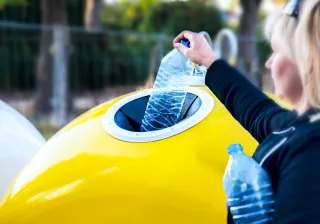The prevailing linear economic model inevitably wastes a large amount of material. The economic model of the future should be based on loops where materials retain as much value as possible, say Maija Pohjakallio (former VTT'er) and Pekka Pohjanne from VTT.
The 2019 international Circularity Gap report, which was published in January, contained some bleak figures on the present state of the circular economy.
Every year, the world economy guzzles 92.8 billion tonnes of minerals, fossil fuels, metals and biomass. Only nine per cent of this total makes it back into circulation.
According to the report, the circular economy will make no progress at the present rate.
When the previous Circularity Gap report was published in 2018, materials were being put back into circulation at exactly the same rate of nine per cent. All the while, emissions of greenhouse gases have continued to increase.
"All the key indicators confirm that the problems of a linear economy are 'baked in' to the global economy and we are heading in the wrong direction," the report states.
Time is starting to run out
It is high time for a change of direction, as the growing world economy is consuming the planet's resources at an increasing rate.
"The latest forecasts indicate that the production of plastic will double by 2030. It is clear that this cannot take place sustainably if growth is based on the use of virgin fossil raw materials. Waste plastic must be put into circulation, and production must also seek a new raw material base," says Maija Pohjakallio. Pohjakallio has led a team at VTT researching new plastic materials and the circular economy for plastics. (Note/3.9.2019: Pohjakallio has been working at Sulapac as Sustainability Director from July 25, 2019)
The same urgency also applies to many valuable metals used in the battery and electronics industries. For example, if lithium is not put back into circulation, there will be no transition to carbon-free energy generation and transportation.
How could the circular economy be promoted rapidly? VTT's report, Going beyond a circular economy, proposes replacing the prevailing linear economy with loops that retain the highest possible value of materials (loss-resistant loops).
Such loops combine production and consumption in ways that enable materials to be reused with the greatest possible refinement value more extensively than at present. The aim is to reduce the consumption of primary materials, waste and emissions, and to improve resource efficiency.
A further aim must be "up-cycling", whereby the value of a product made from recycled materials is equal to or even higher than the initial value of the raw materials. The opposite of this is "down-cycling", where the value of the material decreases.
"We should invest in recovering waste materials and putting them back into circulation. This will require technological development and a new mindset," says Pohjakallio.
When products and production chains are designed, far more attention needs to be paid to the sufficiency of materials, climate impacts and recyclability.
"The most important issue is whether we are using raw materials and other materials smartly and resource-efficiently. This is particularly important when resources are limited. In any case, we have a finite amount of fossil oil. Should we be burning it if smarter uses exist?" asks Pekka Pohjanne, VTT's Research Manager. Pohjanne's own research work focuses on the recyclability of industrial machinery and equipment and extending life cycles.
Maija Pohjakallio emphasises that the sustainabilityof materials must be comprehensively assessed.
"The entire lifecycle, from acquiring raw materials to recycling products, is important and should be taken into consideration already during the design phase. On the other hand, we cannot require all materials to be put into circulation at any cost. We need to consider the net benefit – for example, the amount of energy or auxiliary substances consumed during recycling. Hazardous substances require special consideration in terms of how they can be rendered harmless or taken out of circulation."
Cooperation is crucial
Pekka Pohjanne says that achieving ecologically and economically sustainable loops always requires cooperation between many parties.
"The change begins with a new mindset. Nobody can optimise the reusability or recyclability of materials and products alone. The entire value chain should be interested in the issue and act accordingly.
A new mindset will inevitably foster new business models.
"The new models are more than just forms of networking: they are more like ecosystems that are only vibrant when all of the parties involved are flourishing. It must be possible to demonstrate the environmental and cost impacts throughout the value chain. This requires information to be transferred and shared. Businesses must become more transparent so that information cannot be distorted. Blockchains are one opportunity in this area."
Who bears the responsibility for ensuring that material does not disappear from circulation and value chains?
"Brand owners have a great responsibility. The change will begin with consumer products, as consumers are increasingly demanding better recyclability and challenging the prevailing status," Pohjanne says.
Many brands are already taking responsibility for the operations of their sourcing chains. In the future, more extensive responsibility will be required.
"The responsibility for materials needs to extend beyond the product's use life. About half of the plastic waste separately collected in Europe is currently sent to Asia for processing. Sometimes it is not processed in the agreed way. There is also an enormous problem with plastic ending up in natural areas in the forms of visible litter and microplastics," says Pohjakallio.
Loops will not be built to their full potential unless the traceability of products and materials in circulation can be substantially improved. It would be good to add information to products and their components which indicates what they contain and how the materials are kept in the loop. We also need to intervene in consumption. The use of disposable, single-use products needs to decrease, and products could increasingly be used as services instead of owning them.
"Some manufacturers of industrial equipment offer machines and maintenance as a service, and capacity is offered rather than products. In such cases, it is in the interests of the product manufacturer and the owner to keep the device in working order and return worn out parts to manufacture new products," Pohjanne says.
The best uses for all materials
New alternative materials are also needed. Different industrial sectors could develop solutions together, For example, to build the new plastic economy. This presents huge opportunities for many companies in the fields of chemical industry and forestry industry. Promising start-ups have also begun springing up around new materials.
"One hundred per cent of the plastic in use will never stay in the loop. It is important to reduce the use of single-use products and focus the utilization of plastics on the more demanding applications. There are not many materials the properties of which can be tailored as well than those of plastics. For example, our team is developing plastics for electricity transfer applications, which make use of the lossless insulation properties of plastic. Plastic can replace metals in some applications, thereby reducing metal consumption and benefitting from the lightness of plastics, as well as the fact that plastics do not rust," says Pohjakallio.
Legislation also needs to be reformed. So far, Finland and Europe have developed, for example, waste and chemical legislation in isolation from each other.
"The philosophy of using waste as a raw material did not previously exist. The main focus was on storing or disposing of waste safely. In some cases, waste legislation may complicate or even prevent the recovery of raw materials. As waste becomes a more common raw material in the ecosystem, waste regulation and chemical regulation need to become coherent and support new types of business."
New legislation is already in progress in the EU. For example, separate collection of textile waste will become compulsory in 2025. A hotchpotch of different fibres awaits collectors, and these will not be easy to sort. The circular economy of textiles is being developed for example in the Telaketju project coordinated by VTT.






